Research Article :
Introduction Considering its implementation, the
linguistic and cultural diversity of Mindanao, however, brings much complexity
to the issue of language policy in education. With Mindanaos more than 26
provinces and over 25 million population (Philippine Statistics Authority,
2005), the government offers a challenging environment for implementing a
language policy that is suppose to serve all Mindanao regions and the rest of
the country. This language policy is part of a
rising trend around the world to support mother tongue
instruction in the early years of a childs education. In Southeast Asia, this
is apparent in a growing number of educational programs that use the mother
tongue approach. Good examples can be found in Cambodia, Indonesia, Malaysia,
Thailand, Timor LEste and Vietnam (UNESCO, 2007). With all this, the program is
now on its third year as it was implemented in 2011. Looking at this, the shift
towards mother tongue-based multilingual education is not a walk in a highway.
Numerous challenges need to be addressed like the production of materials,
training of teachers, management of resources, and perhaps, the socio-cultural
support to enhance this project. Concentrating on the MTB-MLE program
challenges, this study is hoping to underwrite something of relevant
contribution to the success of the MTB-MLE in Iligan City. Objective
of the study This study envisioned to examine the
challenges affecting the implementation of the MTB-MLE. Views coming from the teachers,
parents and students
from two school will be thoroughly examined. To come up with a very distinctive
output, two elementary schools were chosen as respondents: The Queen of Angels
School of Iligan (QASI) in Acmac, Iligan City and the Northeast-IA elementary
school in Sta. Filomina, Iligan City. The author believed that the two schools
can provide relative results on the challenges affecting the MTB-MLE in the
current setting. Hence, the following queries are hoped to be addressed
accordingly: 1. What is the general assessment of
the teachers, parents and students about the MTB-MLE? 2. What is the attitude of the
teachers, parents, and students towards the MTB-MLE? Do they support the
program? 3. What trials or challenges arise
relative to the implementation of MTBMLE? Significance
of the study This research addressed the current
and controversial topic in the Philippines which is very relevant in a
multilingual communities like Iligan City which is struggling to define its
educational language policy. Much of the current research on MTB-MLE is
situated in other contexts in which community members have been involved in the
initiative throughout planning and implementation stages. This study only
focuses on the challenges in which way will try to examine the policy and how
it is understood and supported by the stakeholders. It will contribute to the
literature by furthering the construction of local conceptualizations of
language policy outcomes within a larger national policy mandate. Further, the current study addressed
some theories by directing the focus of the analysis to the different policy
perspectives among the teachers, parents and students amidst the current policy
affecting the implementation of the MTB-MLE program. Language policy theory
suggests that language management occurs when external forces make decisions
for those at the ground level (Spolsky, 2011), but there is a need to
understand how language management might occur from the grassroots. While a
growing number of scholars have recognized the importance of involving local
stakeholders in the language policy process (Ricento & Hornberger, 1996),
relatively few studies have examined language policy from the perspective of
those in the community. Analyses of explicit policy statements do not yield
accurate representations on how policy is being carried out from the local
community stakeholders. A number of previous studies have
included only teachers assessment towards language or particular language
policies (Iyamu & Ogiegbaen, 2007). These are important in understanding
local stakeholders perspective of any reform and can help guide policy and
other development leading towards the success of the program. Even more
significant is the growing number of studies that have focused on teachers involvement
in language
policy implementation (Menken & García, 2010). This moves beyond the
mentality of policy as something that is done to people but points to the power
of those at the ground level to make change and become more appealing to all
concerned. Ironically, many of these studies have focused on teachers
resistance to language policies that prohibit using local languages in the classroom
in favor of national if not English language. The current study, however, will
differ because it will consider the ways in which teachers, parents and
students acted in the midst of a policy that supported the use of the mother
tongue. In addition, it will also examine the respondents active roles in the
MTB-MLE program, which is something currently missing in most of the literature
and studies (Ambatchew, 2010). Further, in terms of practical
significance, this research will address current and controversial topic for a
multilingual and multicultural community like Iligan which is struggling to
define its educational language policy. Since our country is the only place in
Southeast Asia to require mother tongue instruction in elementary school, little
is known about the implications of this national decision on a community level.
While hundreds of pilot programs for mother tongue education have been
implemented throughout the region, it is uncertain how they usher effectively
the programs policy to the local environment. Greater understanding on the
perspectives and actions of community members amidst this reform can provide
guidance for the next steps in upholding the program. In particular, since this
study will be conducted while the MTB-MLE program is on its full swing, there
is plenty of opportunity to learn from the stakeholders views and experiences
to shade light for future decision making regarding the MTB-MLE program in
Mindanao especially in Iligan. Glossary
of terms used Bilingual-(Individual or societal) ability to speak two (or more)
languages, or a model of schooling that uses two (or more) languages. Biliterate-Ability to speak, read and write two (or more) languages. Empowerment–Specific efforts to give learners the knowledge, strategies
and self-confidence to act to improve their own situations and those of others. L1-First
language or often interchangeable referred to as mother tongue. L2-Non-native language, second language, foreign language; may
specifically refer to contexts where the language is widely spoken outside the
home, but often used to refer official contexts. Lingua franca-Widely spoken language used for communication between
linguistic groups Maintenance-Continued development of a language through schooling. Medium of instruction-The language used in teaching and learning curricular
content. Mother tongue-First language (L1), native language. Multilingual-(Individual or societal) ability to speak more than two
languages. Transfer-Cummins concept that what is learned in the L1 contributes
to ones competence in other languages Transition Shift in the medium of
instruction from L1 to L2. Transitional-Schooling that shifts sooner or later from the L1 to the
L2. Theoretical
Framework The present study is anchored on
UNESCOs (2007) factors in the success of mother tongue-based multilingual
education program implementation, Bensons (2004), Danbolts (2011) and Malones
(2012) inventory of challenges in mother tongue-based multilingual
education. UNESCO (2007) emphasized that the
effectiveness of mother tongue-based multilingual education necessitates
thorough planning and commitment. The planners need to take into consideration
measures to ensure that the program is effective. These factors are language
model, teacher recruitment and preparation, materials development and
production, parental support, and education sector alignment. These factors guided the researcher
in framing the instrument for the study. They were considered and were modified
by the researcher to fit the present study. The researcher came up with
teachers MTB-MLE knowledge/assessment, instructional materials, and attitude
towards the program as the three main aspects to be considered in investigating
the challenges that stakeholders faced in the implementation of the mother
tongue-based multilingual education in Iligan City. Some authorities outlined challenges
in the implementation of the mother tongue-based multilingual education. This
list of challenges was also taken into account by the researcher. Benson (2004) mentions that one
challenge that may be faced in mother tongue based schooling is human resource
development. This means that human resource development is on the teachers
training. These trainings should not be carried out without appropriate
in-service and pre-service training. Along with this challenge is the
difficulty to find teachers who are competent in the L2. In consequence,
unqualified teachers with less training are hired especially when nationwide
implementation is done. Another challenge according to
Benson is on linguistic and materials development. She says that special
attention should be given to time and resources in the implementation of mother
tongue- education. Educators and people in the community should have time to
work together with linguists to be able to produce materials in the L1. Benson
stressed that there are problems in the implementation sometimes because people
who are involved in the implementation fail to reach a consensus on the
allocation of resources. Moreover, Danbolt (2011) cited
another challenge and that is on the attitude towards the language which is very
important in learning to use one or two languages. Learning a language goes
with attitudes of its users and of persons who do not know the language. When
one has a positive consideration towards the language being used, a feeling of
belongingness and identity exists. Skutnabb-Kangas and McCarty (2006) supports
this idea by saying that positive attitude towards language is in relation to
the feeling of being at home with the language. Benson (2004) posed that the
use of the mother tongue in the classroom makes students feel good about school
and their teacher. This happens because they are becoming knowledgeable in a
language familiar to them. This makes them be encouraged to demonstrate what
they know and participate in their own learning and eventually express
themselves. Malone (2012) as cited by Kadel
(2010) mentioned seven challenges in planning, implementing and sustaining an
excellent mother tongue-based education. These are multiple languages with
multiple dialects, absence of concrete orthographies, shortage of mother tongue
speakers with teaching materials, scarcity of written literature, various
mother tongues, large class sizes, and deficiency of curriculum and
instructional materials. Kadel also pointed out that challenges may also be
faced on poor coordination among government agencies, misconception and
differences in the knowledge about mother tongue-based multi-lingual education,
confusion of parents about the notion of mother tongue-based multilingual
education, qualms among teachers in the government schools due to the
apprehension of losing their jobs, eagerness of parents to send their children
to go to schools with English as medium of instruction, making MTB-MLE
inclusive for all since it aims for the utilization of non-dominant languages
speaking children only, and the unfair allocation of financial resources from
the agencies. Review
of Related Literature and Studies This part of the paper will present
the related literature and studies emphasizing the theoretical bases of the
present investigation. It incorporates theories relevant to the Mother Tongue
Based-Multilingual Education and its challenges. First, Mother Tongue-Based Multilingual Education. The United Nations Universal Declaration on
Human Rights (1948) affirmed the right to education without discrimination.
Article 2 of this document significantly addressed discrimination on the
grounds of language. Five years later, a well-cited UNESCO (1953) report
expanded upon this by suggesting that education in the mother tongue serves
multiple purposes: It is axiomatic that the best medium
for teaching a child is his mother tongue. Psychologically, it is the system of
meaningful signs that in his mind works automatically for expression and
understanding. Sociologically, it is a means of identification among the
members of the community to which he belongs. Educationally, he learns more
quickly through it than through an unfamiliar linguistic medium. (UNESCO, 1953) In the 1999 UNICEF statement
similarly acknowledged the value of mother tongue instruction: There are ample
researches showing that students are quicker to learn to read and acquire other
academic skills when first taught in their mother tongue. They also learn a
second language more quickly than those initially taught to read in an
unfamiliar language (UNICEF, 1999). Ten years later UNESCO (2003)
reiterated these points and stated that essentially all researches since 1953
have confirmed the value of education in the mother tongue. Other evidences from research
studies in the Philippines and elsewhere played a role in convincing policy
makers of the potential benefits of mother tongue instruction for language
minority students. Cited in the study conducted by Burton (2013), the benefits
highlighted from these studies include improved academic skills; stronger
classroom participation (Benson, 2004); increased access to education ; and
development of critical thinking skills. Research has also noted the effect of
multilingual education on cultural pride increased parent participation
(Cummins, 2000); and increased achievement of girls (Benson, 2004). Another
major benefit of mother tongue instruction is the foundation it builds for
gaining literacy in additional languages (Cummins, 2000). Two hypotheses relate
to this desired outcome: the threshold level hypothesis and the interdependence
hypothesis. Skutnabb-Kangas (2006) proposed the threshold level hypothesis
which suggests that only when children have attained a threshold of competence
in their first language can they successfully gain competence in a second
language. This hypothesis was formed as a result of research with Finnish
children who had migrated to Sweden. It was found that children who migrated
before they had gained literacy in their first language did not develop second
language literacy as successfully as those who migrated after they developed
first language literacy. Based on these, Cummins (2000)
consequently devised the widely cited interdependency hypothesis which asserts
that the level of second language (L2) proficiency acquired by a child is a
function of the childs level of proficiency in the first language (L1) at the
point when intensive second language (L2) instruction begins. He distinguished
between two kinds of literacy: interpersonal communication and cognitive academic
language proficiency (CALP). Interpersonal communication refers to oral
communication skills use in conversational settings, while CALP signifies the
point at which the speaker can use language in decontextualized ways, such as
through writing where language is a cognitive tool. Cummins concluded that L1
competency would be more easily transferred to L2 competency when CALP is fully
learnt. The relationship between the L1 and
L2 or L3 is particularly relevant in the Philippines because of the economic
opportunities associated with English proficiency. As generally perceived,
English would facilitate faster mobility—a kind of idea that Hall (1997)
positively posters. In 2009, over 11% of the population worked overseas to
provide 13.5% of the national GDP in foreign remittances (Bangko Sentral
Pilipinas, 2010) and domestically-based call centers for foreign companies
supplied about 4.5% of the national GDP in 2009 (USED, 2010). As a result of
the strong national and individual economic benefits of English proficiency,
there is a strong desire in the country to improve the English literacy skills.
Most researches on literacy outcomes
related to mother tongue instruction were done in North America and Europe. In
spite of this Western focus on language learning studies, it has served for
much of the rationale in propagating usage of the mother tongue in education
throughout the rest of the world. Researchers like Ramirez (1991), Thomas and
Colliers (1997) major longitudinal studies in the United States found that
language minority children who were educated in their home language for a
majority of their elementary school years demonstrated stronger gains in
English proficiency than other language minority children who were educated
only in English or for just a short time in their first language. The finding
is being reinforced by other research that has suggested strong first language
abilities will advance cognitive development in children and allows them to
easily negotiate in other subject matter (Mallozzi and Malloy, 2007). Other
studies also indicated that English (or other second language for this matter)
literacy skills develop more easily and efficiently when they are based in a
childs understanding of their first language (Cummins, 2000). Other researches outside of the
Western context have produced similar outcomes. One of the most well-known
MTB-MLE initiatives took place between 1970 to1978 in Nigeria. The result
showed that students who learned in their first language for six years
demonstrated higher overall academic achievement than students who only learned
in their first language for three years. The first group showed no difference
in English proficiency from the second group despite having had fewer years
with English as the medium of instruction (Fafunwa, Macauley, & Sokoya,
1989). In our country, the Philippines, a
longitudinal study was conducted with the grade one to three students in
Lubuagan, a rural community in the Cordillera Mountains. The mother tongue
pilot project began in one school in 1999, and the study was formally launched
in 2005 with three schools in the experimental group and three in the control
group. After three years of the study, consistent advantages were noted for the
children in the mother tongue schools. They scored significantly higher than
students in the control schools in math, reading, Filipino, and English (Walter
& Dekker, 2011). Field researcher, Akinnaso in 1993
reviewed literature on mother tongue based programs in developing countries and
claimed that most projects yield positive correlations between the development
of literacy in the mother tongue and development of literacy in the second
language. However, the use of the mother tongue alone does not guarantee an
overall positive result. Consideration must be given to the ways in which the
policy is implemented, both from a national and local standpoint. Scholars from anthropological
traditions have argued that top-down language
policy issues give more weight to expert knowledge than local knowledge
(Canagarajah, 2005). While the quantitative evidence found in the
aforementioned studies validates the use of MTB-MLE, it does not account for
local understandings of language learning. Context shapes the way in which
policy can be implemented, and those at the ground level create their own
knowledge about effective and ineffective strategies even if they are not
recognized in scholarly literature (Canagarajah, 1993). While local knowledge
should be considered, Canagarajah (2005) warns about the possible consequences
of regarding it exclusively. He pointed out that celebrating local knowledge
should not lead to ghettoizing minority communities, or forcing them into an
ostrich-like intellectual existence. The bridge between these two types of
knowledge must be created for a good understanding to transpire. The success of multilingual language
policies at national and local levels is dependent upon the presence of
ideological and implementational spaces. Hornberger (2002) introduced these
terms in her seminal work on the continua of biliteracy to explain how local
stakeholders could take advantage of openings in language policy to promote
multilingual education. She suggested that ideological spaces are opened up
when societal and policy discourses begin to accept and value non-dominant
languages for education. In our country, the policy has created an opening for
this ideology, but it is unclear if the societal discourse will follow. On the
other hand, implementational spaces are created when content and media for
instruction utilize local, contextualized viewpoints rather than the majority,
decontextualized perspectives traditionally observed in educational systems. As observed, while the concepts can
be described separately, they are interrelated in practice. As Hornberger
(2002) stated, it would appear that the implementational space for popular
participation is of little avail in advancing a multilingual language policy if
it is not accompanied by popular participation in the ideological space as
well. Apparently, it appears to influence the other in a way that each is a
necessary component of multilingual education
initiatives. Ideological and implementational domains of language reform
deserve attention when studying the way in which a national policy is
understood and enacted at the local level. Second, Spolskys language policy.
Spolsky (2011) proposed a theory of language policy. He argued that the goal of
a theory of language policy is to account for the choices made by individual
speakers on the basis of rule-governed patterns recognized by the speech
community (or communities) of which they are members. His theory is encompassed
by three assumptions which must be tested and adapted. The first assumption is
that language policy is a social phenomenon constructed in a variety of
domains, including homes and schools. A second assumption, as presented in his
book Language Policy (2004), assumes the presence of three separate but
interrelated components: beliefs, practices, and management (see Figure 1.) The
third assumption focuses on the influence of internal and external forces on
language choice. Spolsky (2011) suggested that these may come from within or
outside of the domain and may be language-related or not. The three components of language
policy deserve closer attention. Language Practices, refer to the language
selections that people actually make. This is often described in terms of the
sound, word, and grammatical choices made within a community including
the societal rules about when and where different varieties of language should
be used. These practices are shaped by the complex ecology of language or the
interactions between language and the social environment (Spolsky, 2004). They
may include decisions made by individuals to use a particular language in one
setting but not another. The language belief, on the other
hand, sometimes referred to as ideology, explain the values held by members of
a speech community toward language and language use. Spolsky (2004) described
it as what people think should be done. While many beliefs may be present
within a community, there is commonly one dominant ideology that favors a
particular language approach. The Language Management is defined
as any efforts made to influence language practices. Sometimes referred to as
language planning, this component emphasizes the direct intervention aimed at
shaping the way in which a policy is enacted. While Spolsky (2004) pointed out
that language managers can include any person or entity that attempts to affect
the language choices of other people, management is most commonly associated
with individuals or documents possessing legal authority. An example could
include written legislation in support of a particular language policy. Indeed,
so political in nature. And Third, Ricento and Hornbergers language policy and
planning model. Ricento and Hornbergers (1996) language planning and policy
(LPP) model complements and enhances Spolskys theory by considering actors
within each of the national, institutional, and interpersonal levels. In this
ground, the national level refers to the language policy statements; the
institutional level refers to parents as actors in the community; and the
interpersonal level refers to teachers as players inside the classroom. An
examination of each level of Ricento and Hornbergers (1996) model highlights
how reform implementation approaches from the national or community level
interact to influence implementation at the classroom level. Ricento and Hornbergers (1996) model
is depicted as the layers of an onion that together make up the Language Policy
(LP) whole and that affect and interact with each other to varying degrees.
Each layer infuses and is infused by the others. The figure below, figure 2,
illustrates this model by depicting the agents, levels, and processes involved
in language planning and policy. Agents from all three levels (national,
institutional, interpersonal) interpret the language policy goals and
objectives, and then negotiate between and within levels about the policy
implementation process. The LP model considers language planning and policy
implementation as a multidirectional process that considers downward and upward
priorities. This is depicted by dotted lines and concentric circles, which
demonstrate movement and interactions between the national, institutional, and
interpersonal levels of the model in language policy interpretation. This
process can create conflict and ambiguity in policy goals and objectives, resulting
in misalignment between layers (Ricento & Hornberger, 1996). Figure 2: Ricento and Hornbergers (1996) model. The multidirectional nature of
language interpretation and implementation is a necessary, but conflict-laden
process. It suggests that language policy is not simply defined by national
level implementers. Rather, the onion model depicts the complexity at play in
shaping decisions made at a local level. Teachers are specifically noted for
their role in reform implementation. In the study of García and Menken (2010)
they pointed point out: It is the educators who cook and
stir. The ingredients might be given at times, and even a recipe might be
provided, but all good cooks know, it is the educators themselves who make
policies--each distinct and according to the conditions in which they are cooked,
and thus always evolving in the process. While the role of educators in the
interpersonal level of this model is given much attention in theory and
practice, less attention has been given to the alignment and interactions
between teachers and parents within the same community. Thus, this study will
utilize the classroom, community, and national policy levels in Ricento and
Hornbergers (1996) LPP model as a lens from which to view Spolskys (2004, 2011)
three components of beliefs, practices, and management. Research Methodology and Design The researcher adopted the
Qualitative Participatory Method by Davies and Dart (2005). Such approach is
deemed appropriate for the current study. The method was administered by making
use of a direct classroom observation, questionnaire, and interview. The
questionnaire is necessary for it serves as springboard in the latter interview
with the respondents. Data were collected in July, August and September 2014 in
two schools in Iligan City (QASI and Northeast 1A). The qualitative component
consists of random interviews with the grades 1 to 3 teachers, parents, and
students. The researcher randomly selected 10 teachers, 10 parents, and 10
students per school; with the total of sixty (60) respondents all in all. The
interview questions focused on the knowledge/assessment, attitude, challenges
and other concerns that they have encountered which may affect the MTB-MLE
implementation. The quantitative component includes a questionnaire in which
the grades 1 to 3 respondents responded to items related to their knowledge,
instructional materials, attitude, and challenges about MTB-MLE in general. In
addition, classroom observations were also conducted. Observations included the
classroom environment as well as teaching practices and student responses. Locale
of the study The study was conducted in two
elementary schools, the Queen of Angels School of Iligan (QASI) in Acamac,
Iligan City and the Northeast 1A Central Elementary School in Sta. Filomena,
Iligan City. The respondents speak Binisaya and a handful few can speak Maranao
and Tagalog. These two schools are offering complete elementary education and
in these schools the grades 1 to 3 students with their parents and teachers
were used as respondents of the study. Table 1: The Students First Languages in the Three Grade Levels. Table 2 reveals the number of grade
1, 2, and 3 classes in the two schools. The QASI has 1 section per grade level
for grades 1, 2, and 3. On the other hand, there are a total of five grade 1
classes, five grade 2 classes and six grade 3 classes in Northeast 1A with a total
of sixteen sections all in all. Obviously, it can be seen in the table that
Northeast 1A has a bigger population compared to QASI. For equal treatment of
respondents, however, the researcher decided to use only ten (10) per group of
respondent – that is 10 parents, 10 teachers, and 10 students per school with
the total of sixty (60) respondents all in all. Table 2: Number of Grades 1, 2 and 3 Classes in the two Schools. Research
Participants The participants of the study were
the grades 1, 2, and 3 students, teachers and parents from two elementary
schools (Private and Public) in Acmac and Sta. Filomena, Iligan City. Table 2
shows the distribution of grades 1, 2, and 3 classes in the two schools. Of the
nineteen classrooms, only 10 parents, 10 teachers, and 10 students per school
were being randomly selected as respondents. Hence, it will give the total of
60 respondents from both schools. Table 3: The Distribution of Teacher-Participants in the two Schools. The twenty teachers in both schools
used Binisaya as their first language. Table 3 also reflects the number of
respondents per year level and the teacherparticipants first language. Three
(3) teachers are from grade 1, three (3) from grade 2, and another four (4)
from grade 3. Each school has equal respondents per year level with the total
of twenty (20) teacher-participants all in all. Table 4: The Distribution of Parent-Participants in the two Schools. The twenty parents in both schools
used Binisaya as their first language. Table 4 reflects the number of
parent-participants and their first language. Table 5: The Distribution of Students-Participants in the two Schools. The twenty students in both schools
used Binisaya as their first language. Table 5 reflects the number of
student-participants and their first language. It can be gleaned from the set
of tables above that both schools are equally represented starting from the
teachers up to the parents and pupils. Table 6: Teachers, Parents, and Students First Languages in Grades 1, 2 and 3. The table reflects that the 60
respondents have Binisaya as their first language. Sampling
Procedure Used A random sampling was used in the
study. The researcher had chosen only two elementary schools because of the
following pragmatic reasons: a) accessibility; b) financial consideration; and
c) time affecting the data gathering. Instrument
Used The researcher adopted and modified
Amor Claridos (2013) questionnaire which was constructed based on UNESCOs
(2007) factors in successful implementation of mother tongue-based multilingual
education and on the challenges outlined by Malone (2012). The questionnaire was
validated by an expert. Revisions were done to adopt the experts suggestions
and the final questionnaire was produced. The questionnaire has three parts.
The first part is on the profile of the participants (see appendix A). The
second part is a checklist with items related to the MTB-MLE information and
the third is on the challenges. The last part allowed the respondents to rank
the other challenges that they might have encountered in regards to the MTB-MLE
implementation. Data
Gathering Procedure The researcher followed the
resourceful steps in gathering the data for the study. This made the whole
conduct of the research tedious and exhausting. A letter asking permission was sent
to the school principals in the two chosen schools (see appendix C). The researcher
scheduled a five-day visit per school. He first visited the QASI then the North
East 1A there after. The scheduling was based on the availability of the
respondents per school. The signed and duly approved letter of permission was
handed to the teachers per year level as well as the parents. The
questionnaires were then administered and were retrieved immediately after the
respondents answered them. The Interviews were conducted after
the observation and retrieval of the questionnaires. The researcher looked into
the reading materials used by the grades 1, 2, and 3 teachers in both schools.
Since almost the same materials were available in the two schools, the
researcher considered the materials in the second school. He also tried to look
into the different materials used by teachers in the both schools and tried to
document the observations. Looking into the materials, some probing questions
were thrown by the researcher to gather information that may help the
researcher in understanding the challenges the teachers may have faced. The
classroom observations were done to gather data on how children responded to
mother tongue teaching and how teachers delivered
their lessons in the mother tongue. The data gathered from the questionnaire
helped the researcher understand peculiarities in the classroom. Finally,
probing questions with the respondents were also conducted to clarify some
responses in the checklist, to verify their comments reflected in the last part
of the questionnaire, to ask about some clarifications on the materials used,
and to elaborate some events that had happened during the classroom
observations. Data
Analysis The data on the challenges met by
the respondents in two schools were analyzed based on Besons (2004) and
Danbolts (2011) challenges in MTB MLE. Statistical
Treatment After the data were gathered the
researcher used frequency and percentage to come up with the results. Results
and Discussion Table 7 and 8 present the challenges
faced by the respondents in regards to the implementation of the mother
tongue-based multilingual education. The table reveals the respondents
knowledge/assessment in MTB-MLE. From the private school, it can be seen that
items 1 to 7 which talk about their MTB-MLE knowledge, of the 30 respondent,
they indicated that they are knowledgeable about the program. A negligible
percentage covering items 3 and 4 (on MTB information and knowledge on how to
carry out the MTB-MLE) that would count to 7% and 10% only. This indicates,
though so little, that the parent-participants considered these two items as
challenges in teaching the MT Binisaya to their children. Two parents do not
have enough information and that they are not adequately equipped with
knowledge about the MTB-MLE. As for the public school, parents are very
skeptical in regards to their responses. As reflected in the table, though
majority of them know about the MTBMLE program, but a handful few claimed that
they are not totally knowledgeable about it. This does not, however, affect the
whole sentiment of the 30 respondents especially the teachers and pupils coming
from the public school. The responses in tables 7 and 8 vary
when it comes to MTB-MLE Knowledge. The parents in particular were not all
knowledgeable about the program. Items 3 and 4 give 7% to 10% variance compared
to the parents in private school. This result implies that not all parents are
updated about the program. Teachers and students, on the other hand, are saying
that they are knowledgeable. This finding agrees with UNESCOs (2007) as cited
in the study of Ball (2011). With mother tongue used in the classroom, UNESCO
(2007) pointed out that the use of the MT in the classroom would make the
pupils express what they want to convey. This happens because pupils are able
to understand what is discussed in the class and they are able to speak because
they use their own language. This case is true in the present study. Further,
the same finding is revealed in the study of Chihana and Banda (2011). Table 7: Participants Responses for the MTB-MLE Knowledge (Private). Table 8: Participants Responses for the MTB-MLE Knowledge (Public). The most obvious implication here is
the displacement of English and Filipino as media of instruction. This is one
reason why DepEd Order No. 74 is believed to have both supplanted the official
bilingual education policy of the country which has been in place for almost
three decades now, and ushered in the possibility of a multilingual education
in the Philippines. Whether MTB-MLE succeeds in the end still remains to be
seen because of the many challenges it must hurdle (Nolasco), education in the
Philippines.Whether MTB-MLE succeeds in the end still remains to be seen
because of the many challenges it must hurdle (Nolasco), but one factor that
needs to be recognized is that MTB-MLE claims to be additive (as opposed to
subtractive) in its approach to multilingual education. While teachers and parents differed
in their knowledge of the MTB-MLE policy, their awareness of the guidelines
similarly came from the national level. Those from QASI, considering their
frequent visit in the school, it can be deduced that their queries about the
MTB-MLE would somehow addressed by the teachers or even the principal they see
every now and then. Parents from Northeast 1A, however, received even less
information about the program as it was relayed to them only through their
brief meetings with teachers. In some cases, they had not completely understood
it all. This demonstrated a weakened diffusion of knowledge (Wedell, 2005) in
which information filtered down through a series of different sources of
information. While teachers and parents in this study were aware of the
logistical aspects of the policy related to their specific roles, they had less
understanding about the more nuanced aspects of the policy, including the
rationale for the MT implementation. Tables 9A and 9B present the
challenges the participants faced in the implementation of mother tongue-based
teaching in terms of instructional materials. Table 9A: Participants Response on the Instructional Materials (Private). Table 9B: Participants Response on the Category Instructional Materials (Public). Table 9A shows that the item The
lessons in the manuals are easy to follow 3 teachers answered no while
the item There are enough materials other than the teachers manuals to
aid the pupils in learning the mother tongue 8 of the parents answered no, 5
from the teachers, and 4 from the students. For item the lessons in the manuals
are easy to follow, 3 of the parents answered no, 2 from the teachers and 2
from the students also answered no. For the item Time specified in the manual
is enough to carry out the content, 5 parents, 3 teachers and 4 students
answered no. These notable responses would manifest that MT instructional
materials remain inadequate in their school thereby affecting academic
instruction and pupils academic performance. It further implies that teachers
might resort to hunting for Mother Tongue (MT) references even though they are
not sure of the material suitability or effectiveness when used in the class. In the interview, it was mentioned
by Teacher Jenilyn that they learned that they would be implementing the MT
only one week prior to the start of the school year. They did not receive MT
materials right away; rather during the second week of school they were
provided with curriculum guides that listed core competencies. Later, school
heads provided them with teachers guide that included some lessons and student
worksheets, but these materials had to be reproduced at the cost of the
teachers. Teachers claimed that their teaching had suffered because of the
limited materials. According to her: This kind of statement was commonly
heard among her fellow teachers. Another teacher explained that they are
grappling in the dark to navigate their way through this shift without
resources. Materials provide guidance for teachers, and they all expressed this
during their meetings. She said, DepEd says grade one teachers are the champion
of change, but how can we be the champions of change if we dont have enough
materials? Teachers confined their lament to the classroom and other school
contexts. Teachers compensate the challenges based on their own knowledge,
beliefs, and practices, but the national level did little to address them.
Fullan (2003) suggested: One of the basic reasons why planning fails is that
planners or decision makers of change are unaware of the situations faced by
potential implementers. They introduce changes without providing a means to
identify and confront the situational constraints and without attempting to
understand the values, ideas, and experiences of those who are essential for
implementing any changes. Table 9B shows that item Manuals for
other-tongue are provided was lightly marked by 3 parents with no answers. The
remaining items were marked heavily with 100% no answers by all respondents
from Northeast 1A. They stood incongruent to what has been expected by the
researcher. This would imply that the school lacks or had limited MT materials
to carryout the teaching in the classroom. The researchers visit to the
classrooms made this challenge clearer. It was revealed that aside from one
copy of the teachers manual provided to each grade one and two teachers, only
one copy of the learners material was provided to each of them. This one copy
of the learners material is not enough for more than forty pupils in one class.
This gave the teachers problem since they had to draw on the board (if not on
the chart) the figures found in each page of the learners material to be able
to deliver it to the pupils. Teachers Joycelyn Alisbo and Rosanna Langilao
cited that their time spent on drawing the figure almost consumed the whole
period every time they conduct their classes. They had to do it anyway since
they lack resources in producing the materials. On the other hand, parents
described the lack of resources in a slightly different way. They hinted other
means of acquiring Binisaya books and resources
available to them for use at home and described the challenge of working with
their children without those resources as (lisod kaayo) very difficult. These
materials have not been adequately produced by the government, much less for
commercial purposes. This case is also true in the study of Clarido (2013) in
Bukidnon. The same case in Kenya in the study of Gachechae (2010) and in
Nigeria in the study of Iyamu (2005). In Kenya and Nigeria, the lack of
instructional materials in teaching the mother tongue hindered the teaching of
the content to the local languages. UNESCO (2004; 2007) stressed that materials
should be available for the delivery of the languages. Teachers in the study described
their coping mechanism as the development of collaborative relationships.
Despite the complex environment for addressing the challenge, the level of hope
remained high for both teachers and parents. Despite the complex environment
for addressing this challenge, the level of hope remained high for the teachers
and parents. Table 10 (A and B) present the
challenges faced by the teacherparticipants in terms of attitude towards
language. Table 10A: Participants Response on the Attitude towards Language (Private). Table 10A presents a positive
response of the respondents from the private school. Only a 2 parents answered
no for the item I am happy for the MTB-MLE program. It is a negligible
percentage which would otherwise speak that majority of the respondents from
QASI is happy about the MTB-MLE program. While they could see that
MTincreased understanding in the first years of education, this benefit might
not appear to extend to higher grades. This may be the difference between
what teachers and parents have observed and what they have not yet observed
Guskey (2002). The MT immediate benefits were apparent, but it was more
difficult for them to foresee how this advantage could extend in the future
grades of their children. However, they expressed optimism during the
interview. Mrs. Saldaga confidently expressed it by saying (dali ra man;
problema, wa lay libro) it is easy but the problem is they have no books. Table 10B: Participants Responses on the Category Attitude towards Language (Public). The Table 10B shows that only
teachers and students favored items 1, 2, and 5 which obtained 100% yes
responses. The rest of the items are directing to no answers. The ietms depict
a negative attitude among the parents, teachers, and students. Items 3 and 4
even indicate that the teaching of the mother tongue did not influence the
liking of MT lessons and they are not happy with the program. One parent
answered that it does not help improve pupils attendance. The majority,
however, think otherwise. The interviews with the teachers revealed that the
problem on poor attendance has long been experienced in the schools due to some
factors other than the MTB. This finding agree to what Benson (2009) cited.
Benson said that the use of the mother tongue makes pupils feel good about
school. This implies that when students have a positive feeling towards school,
it would mean that they would also have a positive feeling toward the teacher
and they would eventually come to school. In the case of the pupils, they may have
had a positive feeling toward their teachers but the language used in the
classroom might have not made them feel at home since it was not the language
that they understood better. English was still prevalent. Looking back in items
3 and 4, the teachers and students dont like the lessons in their books and
they are not happy about it. In the interview, it was revealed that their book
lessons were not consistent with the guide that they have in the MT teachers
manual and thereby making their class discussions more problematic. Teacher
Rosanna Langilao said: The teachers manual does not jibe with the textbook.
Another significant point which is worth mentioning is the comment of Teacher
Melba Montecino. She said: We need to provide dictionary for MTB-MLE. Big books
are needed for telling story and in Math discussion. She even pointed out that
she discusses in Binisaya but gave her exams in English. Its confusing.
Makalibog! she admitted. This observation is supported by Teacher Joycelyn
Alisbo: If only we got enough MT materials and books then we can conduct our
class successfully. Such ideas are also evident in the study of Danbolt (2011)
and Burton (2013). Overall, the MTB-MLE appears to
challenge the teachers abilities to implement it in the classroom. Three main
points were uncovered in the data affecting the attitudes of the respondents.
These include the environment of the community, the difficulty in translating
academic language Binisaya to English and vice versa, and the limited resources
and materials available to teachers and parents to support the efforts of the
MT endeavor for the students. In the succeeding questions, the
researcher opted to use them for the parents and teachers only. Other than its
magnitude and depth, it is presumed that these questions would matter for the
parents and teachers only. The teachers and parents respondents were asked to
rank the other factors that may have affected the implementation of the
MTB-MLE. They were asked to identify which of the five challenges is considered
to be on top. Hence they were marking the choices between 1 to 5 and in which
ranking 1 is considered the highest and 5 is the lowest. D.
Other challenges/factors affecting the implementation of the MTB-MLE
(Teachers/Parents Only) Significant insights The interviews, questionnaires, and
observations yield consistent result. MT books and materials garnered the
highest position in terms of MTB-MLE challenges. Looking at it, although the
new MTB-MLE policy and its provisions are good as what advocates have been
fighting for, the rush in implementing the program seems risky and may result
into failure. If the program has to survive, the
researcher strongly suggests that the following challenges need to be addressed
accordingly: Materials development: Materials development would include, among others, books
for both teachers and students must be available in the Binisaya language being
ranked of the MTB- MLE by the two schools. Teacher recruitment and preparation: Availability of teachers who are speakers of the target
languages is also a key consideration for program development. Language distribution: Key questions regarding the distribution of languages
spoken in a community need to be answered in order to design an effective
program. Education sector alignment: To ensure the success of MTB education programs,
governments must structure all aspects of the education system to be aligned in
support of the chosen model. Parental support: Parents support is essential to the success of a mother
tongue education program. Therefore, parents need to be well informed about the
benefits of MTB instruction and reassured that learning in the mother tongue
will not hinder their childrens opportunity to learn a foreign or national
language, often a key goal of sending their children to school. Finally, while
Republic Act (RA) 10533 is in place, MTB-MLE challenges are growing. But such
challenges must not stop the MTs noble intention. Its birthing stage must not
be allowed to die, but must be cherished, nurtured, encouraged until it will be
perfected or so in its practical sense. Elucidating the concurrent challenges
is part in giving a solution. Hence, the researcher put forward the self-made
theory called the Ethno-lingo propagar theory. It means collectively
propagating a community-based learning materials and books to answer the
current educational needs of the community affected by the MTB-MLE program. Table 11: Factors affecting the implementation of the MTB-MLE. Conclusion The stakeholders from the Queen of
Angels School of Iligan and Northeast 1A are supportive of the Mother Tongue
Based-Multilingual Education but skeptical. They seem to believe that the
MTB-MLE is merely affecting the educational change in terms of policy written
in papers but not in practice. The MTB-MLE initiative is promising, but unless
tangible reforms and improvements in the quality of school facilities, teachers
trainings and learning materials, community and government support are
demonstrated, MTB-MLE will remain stuck in the quagmire of lapses as they
affect the program itself and the stakeholders at present. Challenges are
growing. Unless we resolve them, MTB-MLEs future remains vague. Recommendations Based on the findings, the
researcher recommends the following: 1. That DepEd officials, school
administrators, concerned communities and NGOs must find ways to provide the
schools with necessary MT learning materials, especially books, to ensure that
teachers will carryout their lessons successfully. 2. That DepEd should take into
consideration the in-service trainings for teachers. It must be intensified for
teachers handling grades 1, 2, and 3. 3. There is a need for a thorough
information dissemination and or reorientation for stakeholders especially the
parents. 4. Reclaim the childrens right to
learn in their own language through Ethno-lingo propagar theory. 5. Finally, a comparative and
experimental study between and among the private and public learning
institutions will also be conducted in order to measure the MT learning
outcomes quantitatively. References 1.
Acuña,
Miranda. A closer look at the language controversy (1994) In the language issue
in education. Manila and Quezon City: Congress of the Republic of the
Philippines. 2.
Advocacy
kit for promoting multilingual education: Inclusing the nexcluded (2007)
Community members booklet. 3.
Akinnaso.
Development debacle: The World Bank in the Philippines, California (1982)
Institute for Food and Development Policy. 4.
Almario
VS. Mother tongue-based multilingual education (2013). 5.
Ambatchew.
Traversing the linguistic quicksand in Ethiopia (2010) In: Negotiating language
policies in schools: Educators as policymakers, Menken K and García O (edtrs),
New York, Routledge, 6.
Ball
J. Enhancing learning of children from diverse language backgrounds:
Mother-tongue-based bilingual or multilingual education in the early years
(2011) UNESCO, France. 7.
Bangko
Sentral ng Pilipinas. Philippines Overseas Employment Administration (2009). 8.
Benson,
Danbolt. The importance of mother tongue-based schooling for educational
quality: Report Commissioned for EFA Global Monitoring Report 2005 (2011)
UNESCO. 9.
Benson
C. Do not leave your language alone: The importance of mother tongue based
schooling for educational quality (2004) Multilingual Philippines. 10.
Burton.
Mother tongue-based multilingual education in the philippines: Studying
top-down policy implementation from the bottom up (2013) University of
Minnesota, USA. 11.
Canagarajah,
Rajagopalan, Canieso-Doronila, Maria Luisa. The emergence of schools of the
people and the transformation of the philippine educational system (2005)
UP-CIDS Chronicle 3.1 63-97. 12.
Chihana
V, Banda D. The nature of challenges teachers face in using Malawi breakthrough
to literacy (MBTL) course to teach initial literacy to standard one learners in
Mzuzu, Malawi (2013). 13.
Clarido
A. Challenges in the implementation of mother tongue-based multilingual
e Mother Tongue, Multilingual Education
Mother Tongue Based Multilingual Education Challenges: A Case Study
Full-Text
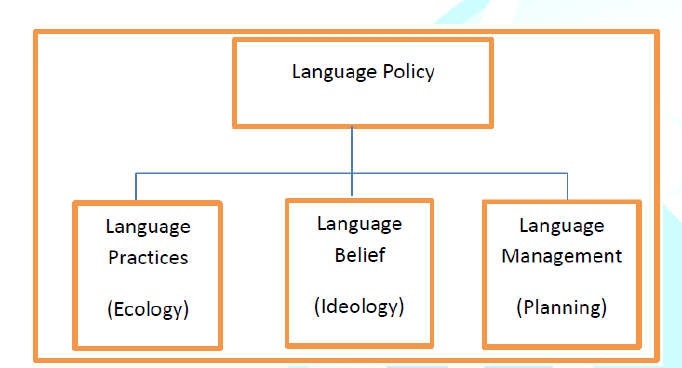
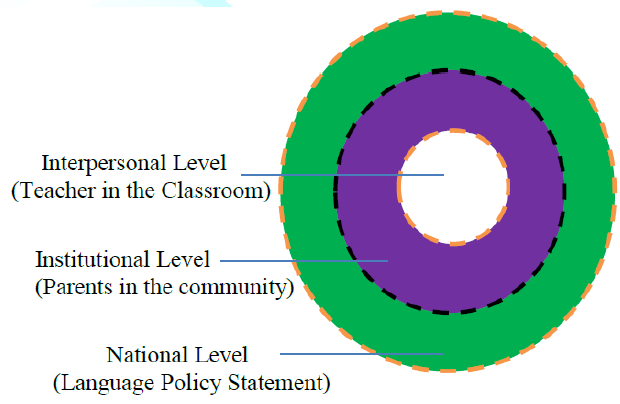






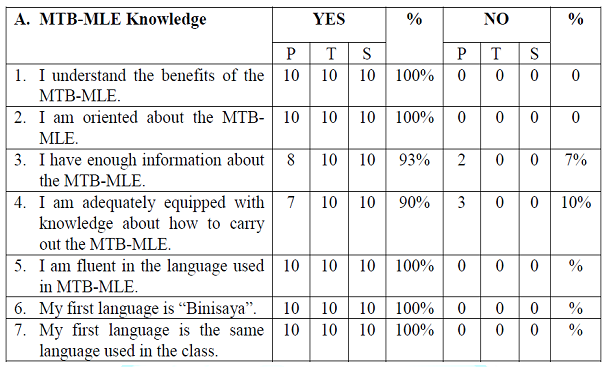
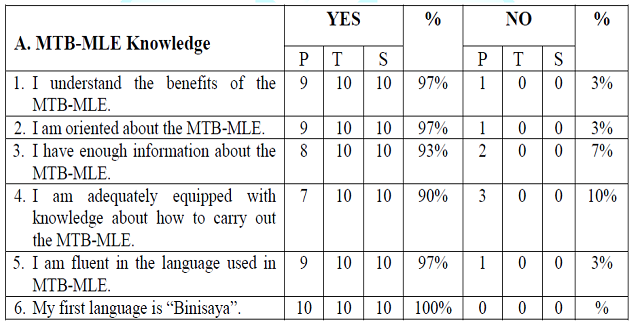
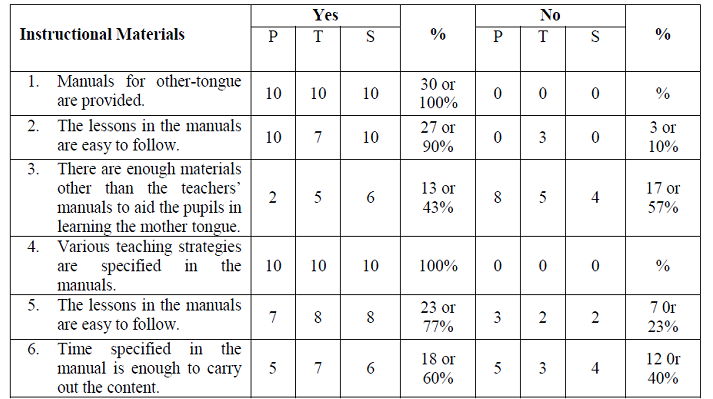
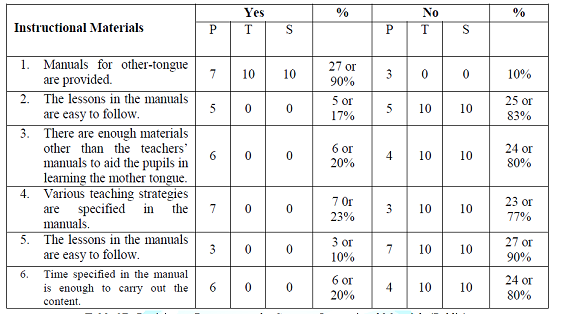
To impart the lessons to the pupils, in my opinion, is easy. Its easy for them
to understand because they can comprehend easily. We could use them if they are
ready, we can execute the lesson clearly to the pupils. What is important are
the materials for us to execute the lessons
properly.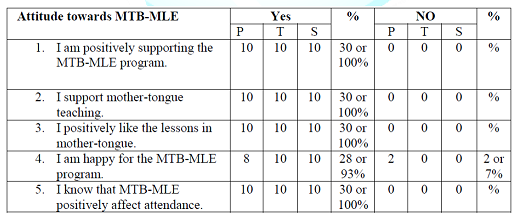
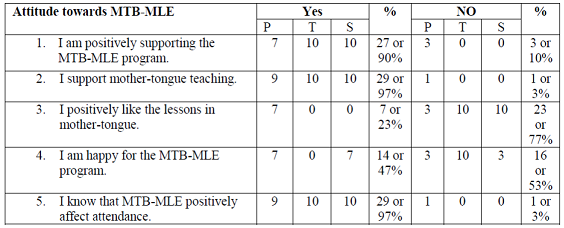
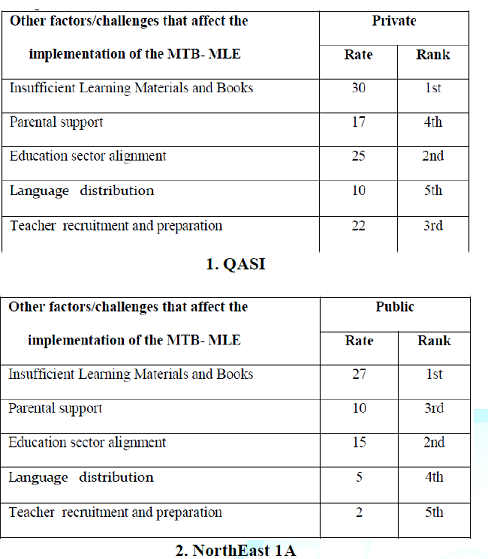
Keywords